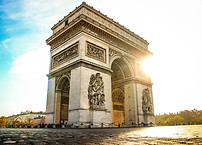
arc de triomphe
Nestled at the top of the Champs-Élysées, the Arc de Triomphe is one of the most celebrated monuments in Paris and, indeed, the world. Following his victory at Austerlitz in 1805, Napoleon Bonaparte ordered it to honor the French army. The Emperor declared to his soldiers, "You will return home through arches of triumph."
However, the construction didn't proceed as smoothly as Napoleon had hoped. Economic difficulties, political changes, and the Emperor's downfall caused the work to halt several times.
The Construction
Initially entrusted to architect Jean Chalgrin, the design took inspiration from the ancient Roman Arch of Titus but on a significantly grander scale. It's a colossal structure, standing 50 meters high, 45 meters wide, and 22 meters deep, making it the second-largest triumphal arch.
Tragically, Chalgrin didn't live to see the arch's completion. After his passing in 1811, other architects oversaw the project. The Arc was finally completed in 1836, during the reign of Louis-Philippe, long after Napoleon's death.
Major Historical Events
Despite the tumultuous circumstances surrounding its construction, the Arc de Triomphe has been at the heart of numerous historical events:
In 1840, Napoleon's remains were passed under the Arc on their return from Saint Helena to the Invalides.
It was the site of the Paris Liberation Parade in 1944, marking the end of Nazi occupation.
Each year on November 11th, the anniversary of the end of World War I, a ceremony is held at the Arc to honor the Unknown Soldier, whose tomb was added in 1921.
Significance Today
The Arc de Triomphe remains a potent national symbol. Its rooftop offers a stunning panorama of Paris, especially impressive at sunset. It's the linchpin of the Axe historique, a sequence of monuments and grand thoroughfares on a route running from the courtyard of the Louvre.
Top 10 Facts
The names of 558 French generals are inscribed on the inner and outer surfaces of the Arc. Those who died in battle are underlined.
The Arc features four main sculptures: "Le Départ de 1792", "Le Triomphe de 1810", "La Résistance de 1814", and "La Paix de 1815."
The monument's design was so influential that it inspired other arches worldwide, including the Arch of Triumph in Pyongyang and the India Gate in New Delhi.
It's adorned with a series of reliefs, the most famous of which is "La Marseillaise."
An eternal flame burns in memory of the Unknown Soldier. It's rekindled every evening at 6:30pm.
The panoramic terrace at the top offers a 360-degree view over Paris.
The monument is the hub of 12 avenues, forming a star (étoile), leading to its alternative name, "Place de l'Étoile."
The structure of the Arc is made of limestone, originating from the Château de Châteaufort quarries.
In 1919, aviator Charles Godefroy famously flew his Nieuport biplane through the Arc during a victory parade after World War I.
The Arc de Triomphe stands on the line's highest point running from the Louvre to the Grande Arche de la Défense.
Visiting the Arc de Triomphe
Tickets for the Arc de Triomphe can be purchased on-site or online through the official website. I recommend the latter to avoid queues. The monument is usually open daily, but checking the opening hours in advance is advisable, as they can change depending on the season or specific events.
The best time to visit would be in the late afternoon or early evening, allowing you to witness the magnificent sunset over Paris from the terrace. Remember that this is also a popular time for many visitors, so be prepared for potential crowds. Despite that, the sight of the Eiffel Tower illuminated against the evening sky is worth the hustle.
A visit to the Arc de Triomphe offers a unique opportunity to step back in time and appreciate the grandeur and history of Paris from a unique vantage point.



